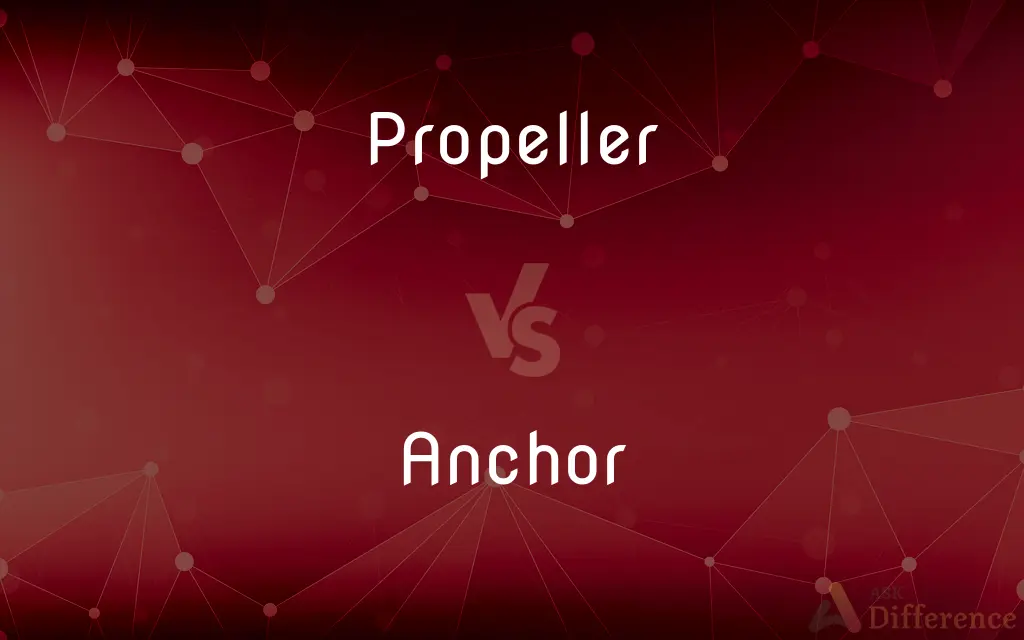Propeller vs. Anchor — What's the Difference?
By Tayyaba Rehman & Urooj Arif — Updated on April 24, 2024
A propeller generates thrust to move vessels through water, whereas an anchor is used to hold vessels stationary by preventing drift.

Difference Between Propeller and Anchor
Table of Contents
ADVERTISEMENT
Key Differences
A propeller is a mechanical device located at the rear of a vessel, consisting of rotating blades that push water backward, propelling the vessel forward. Whereas, an anchor is a heavy device connected to a vessel by a chain or rope, designed to grip the seabed and keep the vessel in place when deployed.
Propellers are vital for navigation and control of speed and direction in waterborne vehicles. They convert rotational power from an engine into hydrodynamic force. On the other hand, anchors are essential for stabilization, ensuring that vessels remain in a designated position despite wind or currents.
The design of a propeller focuses on efficiency and minimal drag to maximize forward movement. It often features adjustable blades to accommodate different speeds and water conditions. Conversely, anchors are designed for maximum holding power, often featuring flukes or plows to dig into the seabed.
Propellers are typically made from materials like aluminum, stainless steel, or bronze to resist corrosion and withstand the mechanical stress of spinning underwater. Meanwhile, anchors are generally constructed from galvanized steel or high-tensile steel, prioritizing strength and rust resistance.
During operation, propellers require careful maintenance to avoid fouling and damage from underwater debris, ensuring efficient performance. In contrast, anchors need regular inspections for signs of wear and corrosion, especially at the joining points of the chain and shank.
ADVERTISEMENT
Comparison Chart
Function
Generates thrust to move vessels
Holds vessels stationary
Location
Rear of the vessel
Deployed from the vessel into sea
Design Focus
Efficiency and speed
Maximum holding power
Material
Aluminum, stainless steel, bronze
Galvanized steel, high-tensile steel
Maintenance Concern
Fouling, blade damage
Wear, corrosion
Compare with Definitions
Propeller
A device with blades that rotate to push against water, creating propulsion.
The boat's engine turned, causing the propeller to spin rapidly and propel the craft forward.
Anchor
An essential safety device for vessels.
During the storm, the anchor prevented the ship from drifting dangerously.
Propeller
Influences the vessel's speed and maneuverability.
Adjusting the propeller's angle altered the boat's speed significantly.
Anchor
A heavy object that holds ships stationary by connecting to the sea bottom.
The captain dropped the anchor to keep the boat stable near the island.
Propeller
Commonly made of metals to resist aquatic conditions.
The ship's propeller, crafted from robust stainless steel, resisted corrosion even in salty waters.
Anchor
Constructed to withstand harsh marine environments.
The anchor was galvanized to prevent rust in the wet, salty conditions.
Propeller
Part of marine and aeronautical engineering.
Engineers optimized the propeller design to improve the speed and efficiency of the new ferry.
Anchor
Can vary in type based on the seabed.
The crew used a grapnel anchor to secure the lightweight skiff in the rocky seabed.
Propeller
Requires periodic maintenance to ensure optimal performance.
The crew scheduled a propeller inspection to remove any entangled seaweed.
Anchor
Regularly inspected for durability and functionality.
The chain links of the anchor were checked for signs of wear and tear.
Propeller
A propeller is a device with a rotating hub and radiating blades that are set at a pitch to form a helical spiral, that, when rotated, exerts linear thrust upon a working fluid, such as water or air. Propellers are used to pump fluid through a pipe or duct, or to create thrust to propel a boat through water or an aircraft through air.
Anchor
An anchor is a device, normally made of metal, used to secure a vessel to the bed of a body of water to prevent the craft from drifting due to wind or current. The word derives from Latin ancora, which itself comes from the Greek ἄγκυρα (ankȳra).Anchors can either be temporary or permanent.
Propeller
A mechanical device for propelling a boat or aircraft, consisting of a revolving shaft with two or more broad, angled blades attached to it.
Anchor
A heavy object attached to a cable or chain and used to moor a ship to the sea bottom, typically having a metal shank with a pair of curved, barbed flukes at one end
The boat, no longer held fast by its anchor, swung wildly
An anchor chain
Propeller
A device for propelling an aircraft or boat, consisting of a spinning shaft with radiating angled blades that thrust air or water in the direction opposite the desired direction of travel.
Anchor
An anchorman or anchorwoman
He signed off after nineteen years as CBS news anchor
Propeller
One who, or that which, propels.
Anchor
Moor (a ship) to the sea bottom with an anchor
We anchored in the harbour
The ship was anchored in the lee of the island
Propeller
A mechanical device with evenly-shaped blades that turn on a shaft to push against air or water, especially one used to propel an aircraft or boat.
Anchor
Present and coordinate (a television or radio programme)
She anchored a television documentary series in the early 1980s
Propeller
A steamboat thus propelled; a screw steamer.
Anchor
(Nautical) A heavy object attached to a vessel by a cable, rope, or chain and dropped into the water to keep the vessel in place either by its weight or by its flukes, which grip the bottom.
Propeller
(fishing) A spinnerbait.
Anchor
A rigid point of support, as for securing a rope.
Propeller
One who, or that which, propels.
Anchor
A source of security or stability.
Propeller
A contrivance for propelling a steam vessel, usually consisting of a screw placed in the stern under water, and made to revolve by an engine; a propeller wheel.
Anchor
An athlete, usually the strongest member of a team, who performs the last stage of a relay race or other competition.
Propeller
A steamboat thus propelled; a screw steamer.
Anchor
The person at the end of a tug-of-war team.
Propeller
A mechanical device that rotates to push against air or water
Anchor
An anchorperson.
Anchor
To secure (a vessel) with an anchor.
Anchor
To secure with a fastener or similar device
Bolts anchoring the deck to the house.
Anchor
To cause to be fixed in place; fix or immobilize
Fear anchoring him in the dark hallway.
Mussels anchoring themselves to a rock.
Anchor
To cause to feel attached or secure
Memories anchoring us to our home town.
Anchor
To provide a basis for; establish or found
"innovative cuisines firmly anchored in tradition" (Gourmet Magazine).
Anchor
(Sports) To serve as an anchor for (a team or competition)
Anchor a relay race.
Anchor
To narrate or coordinate (a newscast).
Anchor
To provide or form an anchor store for
Two major stores anchor each end of the shopping mall.
Anchor
(Nautical) To drop anchor or lie at anchor.
Anchor
(nautical) A tool used to moor a vessel to the bottom of a sea or river to resist movement.
Anchor
(nautical) An iron device so shaped as to grip the bottom and hold a vessel at her berth by the chain or rope attached. (FM 55-501).
Anchor
(nautical) The combined anchoring gear (anchor, rode, bill/peak and fittings such as bitts, cat, and windlass.)
Anchor
(heraldry) Representation of the nautical tool, used as a heraldic charge.
Anchor
Any instrument serving a purpose like that of a ship's anchor, such as an arrangement of timber to hold a dam fast; a device to hold the end of a bridge cable etc.; or a device used in metalworking to hold the core of a mould in place.
Anchor
(Internet) A marked point in a document that can be the target of a hyperlink.
Anchor
(television) An anchorman or anchorwoman.
Anchor
(athletics) The final runner in a relay race.
Anchor
(archery) A point that is touched by the draw hand or string when the bow is fully drawn and ready to shoot.
Anchor
(economics) A superstore or other facility that serves as a focus to bring customers into an area.
Anchor tenant
Anchor
(figurative) That which gives stability or security.
Anchor
(architecture) A metal tie holding adjoining parts of a building together.
Anchor
(US) A screw anchor.
Anchor
(architecture) Carved work, somewhat resembling an anchor or arrowhead; part of the ornaments of certain mouldings. It is seen in the echinus, or egg-and-anchor (called also egg-and-dart, egg-and-tongue) ornament.
Anchor
One of the anchor-shaped spicules of certain sponges.
Anchor
One of the calcareous spinules of certain holothurians, as in species of Synapta.
Anchor
(cartomancy) The thirty-fifth Lenormand card.
Anchor
(obsolete) An anchorite or anchoress.
Anchor
(slang) The brake of a vehicle.
Anchor
(soccer) A defensive player, especially one who counters the opposition's best offensive player.
Anchor
(climbing) A device for attaching a climber at the top of a climb, such as a chain or ring or a natural feature.
Anchor
Alternative form of anker
Anchor
To connect an object, especially a ship or a boat, to a fixed point.
Anchor
To cast anchor; to come to anchor.
Our ship (or the captain) anchored in the stream.
Anchor
To stop; to fix or rest.
Anchor
To provide emotional stability for a person in distress.
Anchor
To perform as an anchorman or anchorwoman.
Anchor
To be stuck; to be unable to move away from a position.
Anchor
A iron instrument which is attached to a ship by a cable (rope or chain), and which, being cast overboard, lays hold of the earth by a fluke or hook and thus retains the ship in a particular station.
Anchor
Any instrument or contrivance serving a purpose like that of a ship's anchor, as an arrangement of timber to hold a dam fast; a contrivance to hold the end of a bridge cable, or other similar part; a contrivance used by founders to hold the core of a mold in place.
Anchor
Fig.: That which gives stability or security; that on which we place dependence for safety.
Which hope we have as an anchor of the soul.
Anchor
An emblem of hope.
Anchor
A metal tie holding adjoining parts of a building together.
Anchor
One of the anchor-shaped spicules of certain sponges; also, one of the calcareous spinules of certain Holothurians, as in species of Synapta.
Anchor
An achorman, anchorwoman, or anchorperson.
Anchor
An anchoret.
Anchor
To place at anchor; to secure by an anchor; as, to anchor a ship.
Anchor
To fix or fasten; to fix in a stable condition; as, to anchor the cables of a suspension bridge.
Till that my nails were anchored in thine eyes.
Anchor
To cast anchor; to come to anchor; as, our ship (or the captain) anchored in the stream.
Anchor
To stop; to fix or rest.
My invention . . . anchors on Isabel.
Anchor
A mechanical device that prevents a vessel from moving
Anchor
A central cohesive source of support and stability;
Faith is his anchor
The keystone of campaign reform was the ban on soft money
He is the linchpin of this firm
Anchor
A television reporter who coordinates a broadcast to which several correspondents contribute
Anchor
Fix firmly and stably;
Anchor the lamppost in concrete
Anchor
Secure a vessel with an anchor;
We anchored at Baltimore
Common Curiosities
What regular maintenance does a propeller need?
Regular maintenance of a propeller includes cleaning off marine growth, checking for dents or damage, and ensuring it is securely attached.
What is the primary purpose of a propeller on a vessel?
The primary purpose of a propeller is to generate thrust and propel the vessel through water.
What safety precautions are associated with anchors?
Safety precautions with anchors include ensuring proper deployment and retrieval procedures to avoid accidents and ensure effective anchoring.
How are propellers attached to vessels?
Propellers are typically attached to the motor's drive shaft, which extends from the rear of the vessel.
What types of anchors are there?
Common types of anchors include fluke, plow, and mushroom anchors, each suited to different seabed conditions.
How do propellers affect the maneuverability of a vessel?
Propellers affect maneuverability by their design and the way they are controlled, allowing precise adjustments in speed and direction.
Is there a difference in maintenance needs between different types of propellers?
Yes, different types of propellers, such as fixed or adjustable blades, have varying maintenance needs based on their complexity and design.
Can the material of a propeller affect its performance?
Yes, the material of a propeller can significantly affect its performance, durability, and resistance to corrosion.
Why is the design of an anchor important?
The design of an anchor is crucial for its ability to hold securely in various types of seabed and under different environmental conditions.
What factors influence the choice of anchor type?
Factors include the size and weight of the vessel, prevailing weather conditions, and the nature of the seabed.
Can a propeller be customized for specific vessels?
Yes, propellers can be customized in size, blade number, and material to match specific vessel requirements and performance goals.
How does an anchor work?
An anchor works by gripping the seabed with its flukes or plow to hold the vessel in a fixed position.
How does the weight of an anchor affect its performance?
The weight of an anchor affects its performance by influencing how well it can secure the vessel against forces like wind and current.
What is the most common problem with propellers?
The most common problem with propellers is fouling and damage from underwater debris, which can impair their function and efficiency.
What role does an anchor chain play?
The anchor chain provides the necessary weight and strength to transmit the holding force from the anchor to the vessel, stabilizing it.
Share Your Discovery

Previous Comparison
Paediatric vs. Pediatric
Next Comparison
Metallophone vs. GlockenspielAuthor Spotlight
Written by
Tayyaba RehmanTayyaba Rehman is a distinguished writer, currently serving as a primary contributor to askdifference.com. As a researcher in semantics and etymology, Tayyaba's passion for the complexity of languages and their distinctions has found a perfect home on the platform. Tayyaba delves into the intricacies of language, distinguishing between commonly confused words and phrases, thereby providing clarity for readers worldwide.
Co-written by
Urooj ArifUrooj is a skilled content writer at Ask Difference, known for her exceptional ability to simplify complex topics into engaging and informative content. With a passion for research and a flair for clear, concise writing, she consistently delivers articles that resonate with our diverse audience.














































